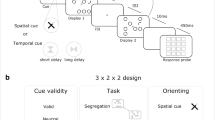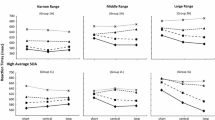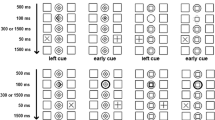Abstract
The requirement to orient attention in space and time usually occurs simultaneously. Previous reports were indecisive regarding possible interactions between temporal and spatial orienting. The present study examined whether temporal and spatial orienting can operate simultaneously and independently in the framework of a detection task. Participants completed three consecutive target detection tasks: in the first two tasks a central cue provided predictive information regarding either the temporal delay of the target or its spatial location. In a third task the temporal and spatial cues from the first two tasks were combined into a single cue. Temporal and spatial information provided by the combined cue could be valid or invalid for each type of information separately. Results from the combined temporal-spatial task revealed that at a short cue-to-target interval temporal validity effects were significant at the attended and unattended spatial locations and were not modulated by spatial validity conditions. Spatial validity effects were also significant and comparable between the valid and invalid temporal conditions. Moreover, temporal and spatial validity effects in the combined task were equivalent to those attained in the separate tasks. At a long cue-to-target delay, spatial validity effects were significant and were not modulated by temporal validity but there were no temporal validity effects. Overall, the results suggest that participants were able to extract temporal and spatial information provided by a single cue simultaneously and independently. We conclude that temporal and spatial endogenous orienting function orthogonally in a task that does not require demanding perceptual discrimination.



Similar content being viewed by others
Notes
The order of the separate tasks (spatial first/temporal first) and type of cue (color/shape) main effects were not significant and did not interact with the effects described.
References
Al-Janabi, S., & Finkbeiner, M. (2014). Responding to the direction of the eyes: In search of the masked gaze-cueing effect. Attention, Perception, & Psychophysics, 76, 148–161.
Berger, A., Henik, A., & Rafal, R. (2005). Competition between endogenous and exogenous orienting of visual attention. Journal of Experimental Psychology: General, 134, 207–221.
Bridwell, D. A., Hecker, E. A., Serences, J. T., & Srinivasan, R. (2013). Individual differences in attention strategies during detection, fine discrimination, and coarse discrimination. Journal of Neurophysiology, 110, 784–794. doi:10.1152/jn.00520.2012
Capizzi, M., Sanabria, D., & Correa, Á. (2012). Dissociating controlled from automatic processing in temporal preparation. Cognition, 123, 293–302. doi:10.1016/j.cognition.2012.02.005
Chica, A. B., Bartolomeo, P., & Lupiáñez, J. (2012). Two cognitive and neural systems for endogenous and exogenous spatial attention. Behavioural Brain Research, 237, 107–123. doi:10.1016/j.bbr.2012.09.027
Chica, A. B., Lupiáñez, J., & Bartolomeo, P. (2006). Dissociating inhibition of return from endogenous orienting of spatial attention: Evidence from detection and discrimination tasks. Cognitive Neuropsychology, 23, 1015–1034.
Correa, Á. (2010). Enhancing behavioural performance by visual temporal orienting. In A. C. Nobre & J. T. Coull (Eds.), Attention and time (pp. 357–370). Oxford: Oxford University Press. doi:10.1093/acprof:oso/9780199563456.003.0026
Correa, Á., Lupiáñez, J., Milliken, B., & Tudela, P. (2004). Endogenous temporal orienting of attention in detection and discrimination tasks. Attention, Perception, & Psychophysics, 66, 264–278. doi:10.3758/BF03194878
Correa, Á., Lupiáñez, J., & Tudela, P. (2006). The attentional mechanism of temporal orienting: Determinants and attributes. Experimental Brain Research, 169, 58–68. doi:10.1007/s00221-005-0131-x
Coull, J., & Nobre, A. (1998). Where and when to pay attention: The neural systems for directing attention to spatial locations and to time intervals as revealed by both PET and fMRI. The Journal of Neuroscience, 18, 7426–7435.
Doherty, J. R., Rao, A., Mesulam, M. M., & Nobre, A. C. (2005). Synergistic effect of combined temporal and spatial expectations on visual attention. The Journal of Neuroscience, 25, 8259–8266. doi:10.1523/JNEUROSCI. 1821-05.2005
Faul, F., Erdfelder, E., Lang, A., & Buchner, A. (2007). G* power 3: A flexible statistical power analysis program for the social, behavioral, and biomedical sciences. Behavior Research Methods, 39, 175–191. doi:10.3758/BF03193146
Gabay, S., & Henik, A. (2008). The effects of expectancy on inhibition of return. Cognition, 106, 1478–1486. doi:10.1016/j.cognition.2007.05.007
Gabay, S., & Henik, A. (2010). Temporal expectancy modulates inhibition of return in a discrimination task. Psychonomic Bulletin & Review, 17, 47–51. doi:10.3758/PBR.17.1.47
Kingstone, A. (1992). Combining expectancies. The Quarterly Journal of Experimental Psychology, 44, 69–104. doi:10.1080/14640749208401284
Lawrence, M. A., & Klein, R. M. (2013). Isolating exogenous and endogenous modes of temporal attention. Journal of Experimental Psychology: General, 142, 560–572. doi:10.1037/a0029023
MacKay, A., & Juola, J. F. (2007). Are spatial and temporal attention independent? Perception & Psychophysics, 69, 972–979. doi:10.3758/BF03193935
Posner, M. I. (1980). Orienting of attention. The Quarterly Journal of Experimental Psychology, 32, 3–25. doi:10.1080/00335558008248231
Rohenkohl, G., Gould, I. C., Pessoa, J., & Nobre, A. C. (2014). Combining spatial and temporal expectations to improve visual perception. Journal of Vision, 14, 4. doi:10.1167/14.4.8
Stafford, T., & Gurney, K. N. (2011). Additive factors do not imply discrete processing stages: A worked example using models of the Stroop task. Frontiers in Psychology, 2, 287. doi:10.3389/fpsyg.2011.00287
Sternberg, S. (1969). The discovery of processing stages: Extensions of Donders' method. Acta Psychologica, 30, 276–315. doi:10.1016/0001-6918(69)90055-9
Sternberg, S. (2013). The meaning of additive reaction-time effects: Some misconceptions. Frontiers in Psychology, 4, 744. doi:10.3389/fpsyg.2013.00744
Acknowledgments
We thank Ms. Desiree Meloul for her helpful comments and useful input on this article.
Author information
Authors and Affiliations
Corresponding author
Electronic supplementary material
Below is the link to the electronic supplementary material.
ESM 1
(PDF 29.5 kb)
Rights and permissions
About this article
Cite this article
Weinbach, N., Shofty, I., Gabay, S. et al. Endogenous temporal and spatial orienting: Evidence for two distinct attentional mechanisms. Psychon Bull Rev 22, 967–973 (2015). https://doi.org/10.3758/s13423-014-0750-y
Published:
Issue Date:
DOI: https://doi.org/10.3758/s13423-014-0750-y




